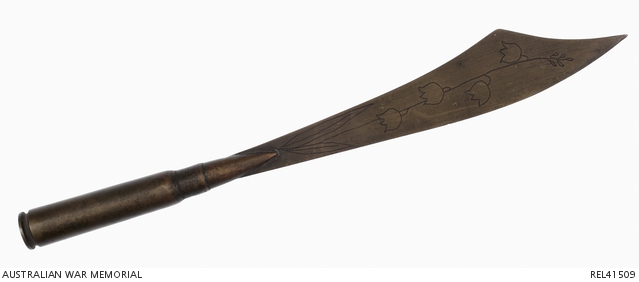| Place | Europe: France, Picardie, Somme, Amiens |
|---|---|
| Accession Number | REL41509 |
| Collection type | Heraldry |
| Object type | Trench Art |
| Physical description | Brass, Lead |
| Maker |
Unknown |
| Date made | c 1916 -1918 |
| Conflict |
First World War, 1914-1918 |
Trench art letter opener : Private H V Reynolds, 1 Field Ambulance, AIF

Decorative trench art letter opener with a German 7.92mm Mauser round as a handle. The blade, which has a flower pattern engraved into it, is constructed from brass sheet and is hafted into the bullet.
This trench art letter opener was brought by Herbert Vincent Reynolds in Amiens, from a crippled French ex-serviceman for six francs, sometime during his time in France in late 1916 or early 1917.
Reynolds was born in 1896 at Sebastopol, Victoria. He enlisted for service in the First World War on 16 September 1914, his 18th birthday. Allocated the service number 622, he was sent to Broadmeadows Training Camp and was allotted to 4 Field Ambulance as a stretcher bearer.
He embarked from Australia with his unit on 22 October 1914 and disembarked at Alexandria in early February. Not long after arriving in Egypt, Reynolds transferred to 1 Field Ambulance. He spent the next two months training before sailing for the island of Lemnos on 5 April.
Reynolds landed at Gallipoli at 9am on 25 April and was immediately set to work. The beaches were still under very heavy fire and many Australians, and even some Turkish casualties, were given treatment before being sent to the hospital ships off shore.
During the August offensive, Reynolds became ill and on 16 August, was evacuated to Mudros with enteric fever. His illness was so severe that he was transported to England and on arrival was sent to King George Hospital in London. Reynolds recovered slowly and did not return to Gallipoli. He was sent back to Egypt in late February 1916 and returned to his unit in early March. In late March, Reynolds and his unit were shipped to France, arriving in Marseilles on 30 March.
Reynolds served throughout Pozieres and the following battles in both France and Belgium. He was wounded on 20 September 1917 during fighting on the Menin Road, receiving a gunshot wound to his left ear. He was evacuated to England on 23 September and spent over a month recovering, before being sent to an overseas training unit for the remainder of 1917.
Reynolds returned to France and rejoined his unit on 26 April near Hazebrouck. The men of 1Field Ambulance remained in this position during the German spring offensive and did not relocate until the Allied August offensive began to push the German forces back.
Reynolds and 32 other men from 1 Field Ambulance left the unit on 3 October for a holding camp before embarking for Australia from Le Havre on 13 October. They had been granted a special six month leave for having enlisted in 1914. He disembarked in Melbourne on 23 December and returned home to Sebastopol. He was discharged from the AIF on 20 March 1919.
Reynolds went on to become Mayor of Sebastopol, serving in this position from 1936-37, 1941-42, 1947-48, 1953-54 and 1959-60. Herbert Reynolds died in 1978.
Related information
Conflicts
Events
Subjects
People
Related Objects
- Reynolds, Herbert Vincent (Private, b.1896 - d.1978)
- Reynolds, Herbert Vincent (Private, b.1896 - d.1978)
- Prussian Erastz (substitute) pickelhaube : Private H V Reynolds, 1 Field Ambulance, AIF
- German army field cap : Private H V Reynolds 1 Field Ambulance, AIF
- Medical bag : Private H V Reynolds 1 Field Ambulance, AIF
- Kodak Vest Pocket Autographic Camera with original box : Private H V Reynolds 1 Field Ambulance, AIF
- Box for Australian Red Cross Society Christmas package, 1918 : Private H V Reynolds 1 Field Ambulance, AIF
- Holdall : Private H V Reynolds 1 Field Ambulance, AIF
- Crucifix : Private H V Reynolds 1 Field Ambulance, AIF
- Service chevrons : Private H V Reynolds 1 Field Ambulance, AIF